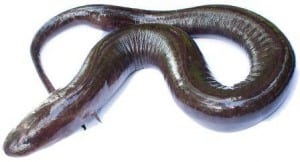Specimen of the Week: Week Fifty-Eight
By Emma-Louise Nicholls, on 19 November 2012
 Not selected solely because I realised I had seriously neglected the amphibians over the last 57 Specimen of the Week posts, the specimen we are going to discover this week is a super species that attracts many a question from museum visitors. Is it a snake? Is it a lizard? Is it a caecilian? Noooooooooo, this week’s Specimen of the Week is…
Not selected solely because I realised I had seriously neglected the amphibians over the last 57 Specimen of the Week posts, the specimen we are going to discover this week is a super species that attracts many a question from museum visitors. Is it a snake? Is it a lizard? Is it a caecilian? Noooooooooo, this week’s Specimen of the Week is…
**The Two-Toed Amphiuma**
1) Amphiumas are crazy looking amphibians with snake-like bodies and tiny weeny arms and legs. A dedicated enthusiast would track a wild specimen down across the Southern parts of the United States. Fossil material can also be found in these areas, dating as far back as the late Cretaceous. Tracing their family history shows that a reduction in the natural range of the two-toed amphiuma has occurred over the last 20,000 years.
2) Not one for the celebrity spotlight, the intimate details of the two toed amphiuma’s love life are not well known. Both courtship and copulation are thought to take place under water, though it has not been proven either way. Wherever they get jiggy, be it land or water, the result is eggs. The female lays her clutch of between 40 and 300+ eggs, in moist, terrestrial sites. The clutch size is directly related to the body size of the female. The eggs are normally laid beneath logs or rocks, near standing bodies of water. Some have been found in the basins of dried or drying ponds which confusingly suggests they were originally laid under water. Could it be that the two-toed amphiuma lays their eggs either on land or under water as per the preference of each individual? One particularly daring or perhaps suicidal female laid her clutch in the nest of an American alligator. Do alligators fall prey to nest parasitism by amphiumas? (If you’re not already smirking knowingly at that suggestion, it wasn’t a serious one… just fyi).
3) When the amphiuma eggs hatch, they emerge as cute little larva with external gills. Sadly, as with most children,the cute phase doesn’t last and the gills are lost after around two weeks. No-one has yet been able to work out what amphiumas eat when in their larval stage, leading some researchers to suggest, given the brevity of the stage, that two-toed amphiuma larvae do not feed at all, but survive to metamorphosis on yolk alone.
4) Two-toed amphiumas are able to survive droughts by either burrowing into the substrate or by occupying crawfish burrows. The maximum length of time the two-toed amphiuma can survive buried and in this state of aestivation is unknown, but research suggests around 13 months.
5) Two-toed amphiumas are chiefly creatures of the night, emerging to forage for tasty morsels in shallow water after the diurnal creatures are tucked up in bed. Fisherman however, often catch two-toed amphiumas during the day, which means either the previous sentence’s scientific fact is baloney, or else these particular fishermen use a kind of bait that’s just too fabulous for the olfactory senses of the amphiuma to ignore. When not munching on fishermen’s tackle, adult amphiumas eat a variety of aquatic insects, reptiles, fish, molluscs, spiders, and even other amphibians. So… pretty much anything then?

Two toed amphiuma. Image taken by Brian
Gretwicke. Image taken from http://commons.wikimedia.org
/wiki/File:Amphiuma_%28two-toed%29.jpg
Emma-Louise Nicholls is the Museum Assistant at the Grant Museum of Zoology
 Close
Close



